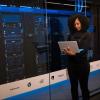Related Content
 |
How Blockchain Technology Will Disrupt Business The security factor has made blockchain popular in finance applications—indeed, it's probably known best as the record-keeping technology behind bitcoin. But there’s more to its prospects than finance. Blockchain stands to be a disruptor in the business world because it has potential applications in so many fields. |
|
 |
Why Choose Containerization? Containers have been adopted by many organizations. Docker is the most popular and has become the standard containerization platform, though there are others. But why use containerization? What are the advantages that spurred its adoption? Let’s look at some of the factors that govern the choice of containerization. |
|
 |
Migrating to the Cloud: Which Model Is Right for You? Cloud computing is a relatively recent trend, and several organizations have opted to migrate their services and data to the cloud. Which of the cloud computing models available is right for which situation? Let’s look at the three options—public, private, and hybrid—and discuss when it's a good idea to use each one. |
|
 |
5 SecOps Challenges and How to Overcome Them SecOps, or security operations, is a collaboration between information security and IT operations to keep a company’s data secure and reduce risk, all while maintaining agile timelines. But it can be difficult to start. Here are five challenges you should address to ensure your SecOps implementation is successful. |
|
 |
Migrating a Database? Consider These Factors First Database migration is usually performed with a migration tool or service. Migrating one database to another actually involves migrating the schemas, tables, and data; the software itself is not migrated. Whatever the reason for migration, before you start, explore the options and take these considerations into account. |
|
 |
Selecting a Cloud Service Cloud services are relatively new, and for those used to downloading and installing software, it may be daunting at first when trying to figure out which cloud service to use. Let’s analyze the different options—infrastructure as a service, platform as a service, and software as a service—and when you should use each. |
|
 |
Explaining Hardware Virtualization and Containerization Virtualization is the abstraction of a computer resource—such as hardware, memory, storage, an operating system, a desktop machine, or a network—built on top of the physical resource. There are many types of virtualization, and here, we look at virtualization of hardware and of an operating system, or containerization. |
|
 |
What’s Different about Testing Serverless Applications? Serverless computing is a DevOps technique that uses cloud-provided runtimes to execute code components in a defined workflow. Testing is easier in some ways with this model, but more difficult in others. Let's dive into the ways testing serverless applications and components is different from traditional architecture. |




